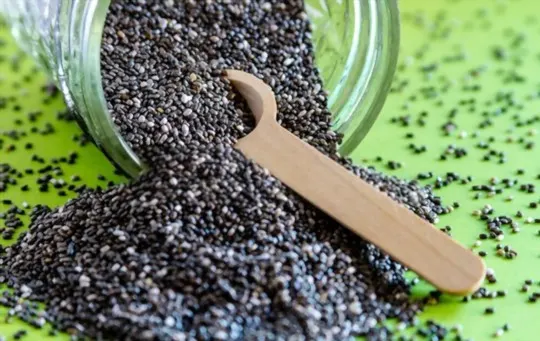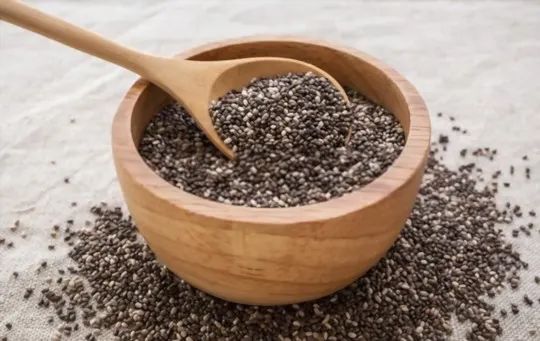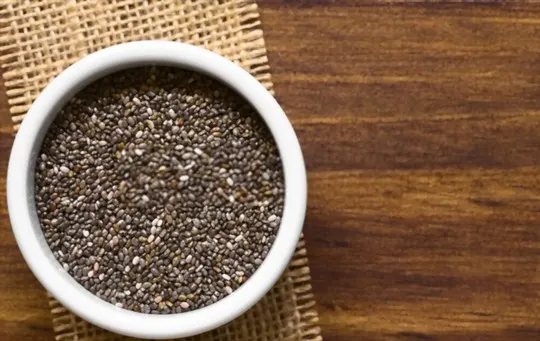Have you ever been curious about what chia seeds taste like?
Chances are, if you’re exploring the endless world of healthy foods, then chia seeds have certainly crossed your radar.
But before taking the plunge and eating something totally unfamiliar to us (which can be daunting!), understanding its flavor profile is essential in deciding if a food is worth incorporating into our diet.
After all, there’s no point in sacrificing flavor for nutrition if we don’t enjoy it!
In this blog post, I’ll guide you through everything that makes the petite and powerful chia seed special — from its earthy undertones to its versatility with country-specific dishes.
Next time someone asks “What do chia seeds taste like?,” you’ll know exactly what to expect — and how best to enjoy it!
What are Chia Seeds?

Chia seeds have been the trendiest superfood for a while, and for good reason.
These tiny black and white seeds from the Salvia hispanica plant are packed with nutrients that are good for your body, making them a go-to addition to any meal.
Chia seeds are excellent sources of fiber, protein, antioxidants, and Omega-3 fatty acids, making them an excellent dietary supplement.
They were a staple in the diet of Aztecs and Mayans for centuries, and now you can incorporate them into your meals today.
Chia seeds are versatile, and can be added to smoothies, yogurt, baked goods, or even made into pudding.
With their unique texture, you can easily enhance your meals with added crunch or a jelly-like consistency.
Chia seeds are easy to find in grocery stores and online, so start adding them to your diet for a boost of nutrition.
What Do Chia Seeds Taste Like?

Chia seeds have a mild, nutty flavor.
When consumed dry, they have a crunchy texture, similar to poppy seeds.
However, when soaked in water or other beverages, chia seeds form a gel-like substance, making them more palatable and easier to consume.
Chia seeds are packed with nutrients, including fiber, protein, omega-3 fatty acids, and various micronutrients.
Despite their small size, they are highly nutritious and a great addition to any diet.
If you’re looking to incorporate chia seeds into your diet, you can add them to smoothies, oatmeal, yogurt, or baked goods.
Overall, chia seeds have a pleasant taste and are highly versatile, making them an ideal superfood to have in your pantry.
To get the most out of chia seeds, soak them in water or other liquids for at least 30 minutes before consuming.
This will help them form a gel-like consistency, making them easier to digest and more palatable.
Nutritional Value of Chia Seeds

Chia seeds are a nutrient-rich superfood that are packed with vitamins, minerals, and healthy fats.
They have a mild nutty flavor and are often used in smoothies, baked goods, and as a topping for salads and yogurt bowls.
Here’s a breakdown of the nutritional value of chia seeds:
- Fiber: Chia seeds are an excellent source of dietary fiber, which is essential for maintaining healthy digestion and preventing constipation.
- Protein: They are also a rich source of plant-based protein, making them an excellent choice for vegetarians and vegans.
- Omega-3 Fatty Acids: Chia seeds contain high amounts of omega-3 fatty acids, which are crucial for brain health and reducing inflammation in the body.
- Calcium: They are also an excellent source of calcium, which is important for maintaining strong bones and teeth.
Chia seeds have a mild and nutty flavor, which makes them versatile and easy to incorporate into various dishes.
They add a crunchy texture to salads and yogurt bowls, and their gel-like consistency makes them an excellent egg substitute in vegan recipes.
Pro tip: To help chia seeds digest better, soak them in water or milk overnight before consuming.
Where to Buy Chia Seeds and How to Store It?

Chia seeds are a nutrition powerhouse, loaded with fiber, protein, omega-3 fatty acids, and other essential nutrients.
They have a mild, nutty flavor and can be easily incorporated into various recipes.
Here’s where to buy chia seeds and how to store them effectively:
- Where to buy: Chia seeds are readily available in most grocery stores and health food stores. You can also buy them online from various retailers like Amazon, Walmart, and Thrive Market. When buying, ensure that the chia seeds are fresh and have a mild smell.
- How to store: Chia seeds have a long shelf life and can be stored in an airtight container in a cool, dry place for up to two years. Avoid storing them in direct sunlight or humid areas, as they may spoil or become rancid. You can also store chia seeds in the refrigerator or freezer to extend their shelf life.
Pro tip: Soak chia seeds in water or milk for 10-15 minutes before consuming, as it makes them easier to digest and improves their nutrient absorption.
Conclusion
In conclusion, Chia seeds are tiny, nutrient-dense seeds that offer a range of health benefits when included in your diet.
They are an excellent source of fiber, protein, omega-3 fatty acids, and minerals like calcium, iron, and magnesium.
Chia seeds have a mild, nutty flavor that complements many dishes, making them easy to incorporate into your meals.
Their versatility and health benefits have earned them a reputation as a superfood.
So why not try adding chia seeds to your diet today and experience their flavor and health benefits for yourself?

What Do Chia Seeds Taste Like? A Comprehensive Guide
Ingredients
- Chia seeds
- Ingredients from your selected recipes
Instructions
- Select ingredients that work well together.
- Use a recipe or method that will enhance their natural taste.
- Taste and adjust the recipe as needed to achieve the desired flavor.

Carrie is a food writer and editor with more than 15 years of experience. She has worked for some of the biggest names in the food industry, including Bon Appétit, Food & Wine, and Martha Stewart Living.
As the Editor in Chief of IntroChicago.com, Carrie oversees all of the content on the site. She also manages the team of contributing writers and editors, who help to create delicious recipes, helpful tips, and informative articles that you’ll find on the site.
A native of the Chicago area, Carrie is passionate about all things food. She loves trying new restaurants and experimenting with new recipes in her kitchen. She’s also a graduate of the Culinary Institute of America, so she knows a thing or two about food!
